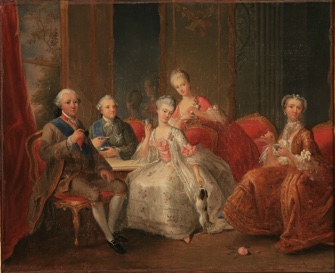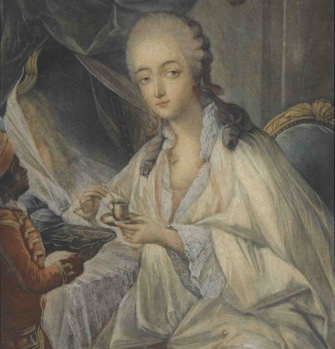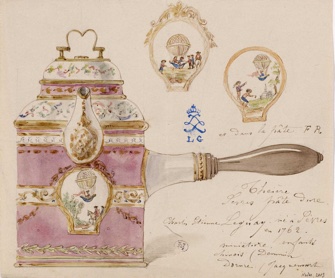‘Foreign Drugs’ in
18th-Century France

“La Tasse de Chocolat” (1768), by Jean-Baptiste Charpentier. Musée Jacquemart-André Chaalis
The Musée Cognacq-Jay, the repository of a collection of 18th-century art and a sort of memorial to the Age of Enlightenment, is currently hosting the exhibition “Thé, Café ou Chocolat?” This exploration of the history of three elixirs so important to refined 18th-century French society looks at the exotic origins of these treasured natural resources, their uses (and abuses) in 18th-century France and how they were consumed.
A veritable cult developed around these sought-after beverages, which had first came into vogue at the French royal court under Louis XIV. Exhibits include royal tea sets, some of the earliest coffee grinders and paintings depicting the intoxicating power of hot chocolate. To enhance this sensory adventure, visitors are invited to poke their noses into tall funnels to sniff the heady fragrances of coffee, tea and cocoa.
The Age of Enlightenment and the Age of Discovery provide the backdrop to the exhibition. The novelty of these unheard-of brews and fragrant potions not only earned them a central role in French social life but also helped fuel an obsession with Orientalism, which grew as new treasures flooded in from India and the Far East. This fascination for exotic “otherness” and the enthusiasm for these potent new nectars was translated into the art of the period.
One painting shows the Countess Du Barry, Louis XV’s official mistress, being served a cup of coffee by Zamor, a Bengalese boy in the

“Jeanne Bécu, Comtesse du Barry, et Zamor qui lui Apporte une Tasse de Café,” by Jean-Baptiste-André Gautier d’Agoty. Chateau de Versailles. Photo © RMN-Grand Palais-Gérard Blot
king’s service. Eroticism, evoked by the scantily dressed Du Barry, mingles with the exoticism of the imported coffee, the foreign servant and the Chinese lacquered tray. The painting is a direct allusion to the king, a coffee lover and the first French owner of Indian slaves.
This fascination with the exotic can also been seen imprinted on exquisite decorative ceramics. On entering one of the rooms, the eye is immediately drawn to two huge vases of fine Japanese porcelain enameled in the Chinese Famille Rose style. These novel designs were popular in the most fashionable of homes.
The exhibition also offers a wealth of detail on customs surrounding the drinks, such as when and how they were consumed at court, and how they influenced Parisian café life and our modern consumption habits. A timeline of

Deaign for a Sèvres teapot, by Charles-Etienne Leguay. © Musée Carnavalet-Roger-Viollet
tableware designs shows how coffee cups and teapots changed over the centuries.
One of the most interesting paintings depicts groups of revolutionaries and journalists gathered at one of Paris’s Patriots’ Cafés, showing how important the beverage was even in political life. A series of paintings by Nicholas Lancret, “The Four Hours of the Day,” teasingly subverts the classical notion of the “four stages of man” by portraying daily life during the Enlightenment in relation to the exotic drinks that were consumed at different times of day. The fact that in the 1700s tea and coffee drinking was already being satirized in art and literature is indicative of the preposterous proportions the craze had reached.
Though compact, the exhibition is packed with a number of fine antiques and pleasing paintings. In the handsome setting of the Hôtel Donon, the mansion the museum in housed in, with its dazzling chandeliers and gleaming wood paneling, visitors are immersed in the world of French high society while the stimulating aromas of tea, coffee, and hot chocolate whisk them off to faraway lands.
Just how intoxicating these brews were considered at the time was expressed in 1716 by the Princess Palatine, who said, “I refuse to suffer any of these foreign drugs; I take neither chocolate nor tea nor coffee.”
Musée Cognacq-Jay: 8, rue Elzevir, 75003 Paris. Tel.: 01 40 27 07 21. Métro: Saint-Paul. Open Tuesday-Sunday, 10am-6pm. Closed on Mondays and public holidays. Admission: €7. Through September 27, 2015. www.museecognacqjay.paris.fr
Reader reaction: Click here to respond to this article (your response may be published on this page and is subject to editing).
Please support Paris Update by ordering books from Paris Update’s Amazon store at no extra cost. Click on your preferred Amazon location: U.K., France, U.S.
More reviews of Paris art shows.
© 2015 Paris Update
Favorite